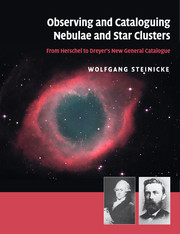Book contents
- Frontmatter
- Contents
- Preface
- 1 Introduction
- 2 William Herschel's observations and parallel activities
- 3 John Herschel's Slough observations
- 4 Discoveries made in parallel with John Herschel's Slough observations
- 5 John Herschel at the Cape of Good Hope
- 6 The time after Herschel's observations until Auwers' list of new nebulae
- 7 Compiling the General Catalogue
- 8 Dreyer's first catalogue: the supplement to Herschel's General Catalogue
- 9 Compilation of the New General Catalogue
- 10 The New General Catalogue: publication, analysis and effects
- 11 Special topics
- 12 Summary
- Appendix
- References
- Internet and image sources
- Name index
- Site index
- Object index
- Subject index
1 - Introduction
Published online by Cambridge University Press: 06 December 2010
- Frontmatter
- Contents
- Preface
- 1 Introduction
- 2 William Herschel's observations and parallel activities
- 3 John Herschel's Slough observations
- 4 Discoveries made in parallel with John Herschel's Slough observations
- 5 John Herschel at the Cape of Good Hope
- 6 The time after Herschel's observations until Auwers' list of new nebulae
- 7 Compiling the General Catalogue
- 8 Dreyer's first catalogue: the supplement to Herschel's General Catalogue
- 9 Compilation of the New General Catalogue
- 10 The New General Catalogue: publication, analysis and effects
- 11 Special topics
- 12 Summary
- Appendix
- References
- Internet and image sources
- Name index
- Site index
- Object index
- Subject index
Summary
THE SIGNIFICANCE OF THE NEW GENERAL CATALOGUE
Besides the point-like stars, the sky offers a large number of objects showing an extended structure. Except for a few, they are not visible without the aid of a telescope. In terms of their optical appearance, there are star clusters (resolvable objects) and nebulae (unresolvable objects). In 1862 Eduard Schöfeld, an astronomer at Mannheim Observatory, gave the following definition:‘Nebulae or nebulous patches are celestial objects, which do not contrast with the sky background as shining points, like individual stars, but present the impression of a more or less extended and diffuse area of light.’
Long before the invention of the telescope, the open clusters of the Pleiades and Praesepe and the diffuse spot of the Andromeda Nebula were known. Later the telescopic exploration of the sky brought many more cases to light. Soon it became evident that some nebulae are disguised clusters of stars; the best examples are globular clusters, the compact and star-rich versions of open clusters. Other objects, such as the bright nebulae in Orion and Andromeda, could not be resolved, even with the largest telescopes. However, in 1864 the new astrophysical method of spectroscopy revealed that the Orion Nebula is a mass of gas (mainly hydrogen and helium). On the other hand, the Andromeda Nebula is a galaxy, consisting of many hundreds of billions of stars, which was eventually proved in the twentieth century.
- Type
- Chapter
- Information
- Observing and Cataloguing Nebulae and Star ClustersFrom Herschel to Dreyer's New General Catalogue, pp. 1 - 13Publisher: Cambridge University PressPrint publication year: 2010



